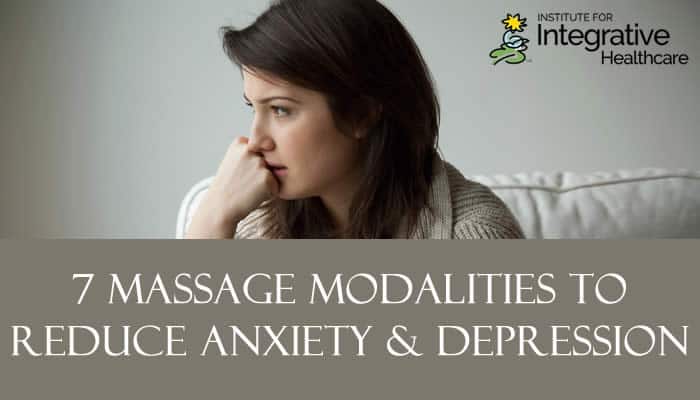

As a massage therapist, we witness clients experience an array of emotions upon our tables, one of which is anxiety. When a client displays anxiety, a therapist needs to know how to assess and interact in a professional manner.
Statistics Provided By the Anxiety and Depression Association of America
- Anxiety disorders are the most common mental illness in the United States afflicting 40 million adults (approximately 12% of the population).
- Less than 40% of anxiety sufferers receive significant treatment in the form of allopathic medications and/or homeopathic remedies.
- People with an anxiety disorder are 3—5 times more likely to visit doctors and be hospitalized for psychiatric disorders.
The Diagnostic Statistical Manual 5 (DSM-5) lists 12 anxiety disorders formally defined by medical practitioners.
Amongst these are:
- Generalized Anxiety Disorder (GAD)
- Panic Disorder (PD)
- Social Phobia
- Specific Phobias
- Agoraphobia
- Separation Anxiety Disorder
- Substance-Medication Induced
- Selective Mutism
- Anxiety caused by a concurrent medical condition
The common threads amongst the varying types of anxiety include:
- The inability to perform work tasks.
- Interference with daily, routine activity.
- Symptoms persisting more than 4 weeks.
- Fear coupled with anxiety and physical dysfunctions resulting from the heightened fight—flight response.
A clinical psychiatrist or psychologist can formally diagnose one with an anxiety disorder.
The Space We Create Matters
A massage therapist may assist clients with anxiety disorders by creating a healthy and safe environment. A session geared toward calming the body’s senses can greatly alleviate symptoms related to anxiety.
- Lighting: Being mindful to keep lighting soft using a non-stimulating source like a salt lamp, as this will help ease visual stimulus.
- Sound: Musical selections devoid of lyrics, using slow-paced tracks, melodic tones, and harmonic rhythms are ideal choices to help one remain at ease upon the table.
- Listening: A massage therapist may end up listening to the concerns of their client during a panic attack or somatic-emotional response during a bodywork session. The therapist needs to remember to remain neutral in language tone, both verbal and non-verbal. Listen empathetically without becoming sympathetically lost in their story. Remain cognizant if you, as the therapist, are developing an emotional attachment to the client, either to help “save” them or if you overly relate to their situation (especially if you have experienced the same incident). Use clear, concise, non-judgmental language. Resist the urge to offer professional advice on the client’s personal, business and social affairs.
Anxiety Linked with Depression
Anxiety disorders are also linked to depression related conditions such as Major Depressive Disorder and Persistent Depressive Disorder.
A client suffering from depression:
- may seem withdrawn
- complain of restless (or lack of) sleep
- have impaired cognition
- fatigue
- changes in appetite
- swift changes in mood and behavior
These complications may exacerbate anxiety conditions.
Healthy Communication
Since there are multiple levels and sources of anxiety, it’s a good idea for a massage therapist to possess multiple business cards of professionals such as social workers, psychiatrists, psychologists, and counselors to provide to their clients with anxiety. While massage may alleviate physical and mental sources of stress, deep-rooted emotional and psychological sources are best managed with advanced clinical care. Providing options from which a client may choose is the best practice when providing recommendations.
An important aspect of ethical communication with anxiety-ridden clients is to ensure these clients are following treatment plans provided by their doctors and other allopathic professionals. Please refrain from discouraging efforts with their health team.
Suggesting homeopathic and/or naturopathic remedies may be helpful; however, be cautious to avoid making specific claims of their effectiveness. Some natural remedies may not chemically interact well with certain anti-depressant or anti-anxiety medications (see below). Encourage your client to contact their doctor and other health professionals to consult if a natural remedy will interact positively within the established treatment plan.
7 Common Anti-Anxiety Medications
- Benzodiazepines (Xanax, Klonopin, Valium, Serax) to treat generalized anxiety and phobias.
- Beta Blockers (Inderal, Tenormim) to treat social anxieties.
- Tricyclic Antidepressants (Elavil, Tofarnil, Norpramin, Adapin) to treat anxiety coupled with depression.
- Anticonvulsants (Lyrica, Depakote, Neurontin) to treatment panic attacks associated with anxiety.
- Selective Serotonin Reuptake Inhibitors—SSRI (Prozac, Luvox, Paxil, Zoloft) to treat PTSD patients with anxiety.
- Serotonin-Norepinephrine Reuptake Inhibitors—SNRIS (Cymbalta, Effexor, Effexor XR) to treat obsessive compulsive disorder (OCD) patients with anxiety.
- Monoamine Oxidase Inhibitors—MAOI (Nardil, Parnate) to also to treat PTSD and/or OCD patients.
7 Bodywork Modalities to Include
Bodywork modalities with success at alleviating anxiety symptoms include:
- Cranial Sacral Therapy
- Lymphatic Drainage
- Myofascial Release
- Polarity Therapy
- Reflexology
- Reiki
- Shiatsu
All of these modalities involve heightening awareness of the practitioner beyond merely feeling muscles. A therapist begins to sense subtle shifts of tissue beyond typical muscle contraction. Encouraging fascial manipulation, lymph movement, and body unwinding can ease long held restrictions within your client’s somatic body.
Conclusion
One last note about working with anxiety clients is to facilitate a healing space in which this client can be heard. Too often, they are dismissed with claims that their sources of anxiety are not valid, assumed to be “acting crazy,” with their concerns and feelings disregarded by friends and family alike. As a massage therapist, you may be their trust confidant through their hardest of times. Be mindful of personal and professional boundaries as we allow the space for this client to share, express, and reveal personal details. Stay within the scope of practice and the intended therapy goals of the present session.













